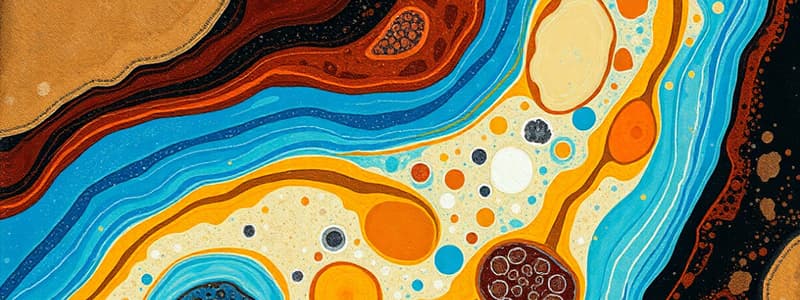Podcast
Questions and Answers
Which of the following is a characteristic of neritic sediments?
Which of the following is a characteristic of neritic sediments?
- Deposited slowly
- Finer-grained sediments
- Dominantly biogenous
- Typically deposited quickly (correct)
What distinguishes pelagic sediments from neritic sediments?
What distinguishes pelagic sediments from neritic sediments?
- Pelagic sediments are typically biogenic in origin.
- Pelagic sediments are dominated by lithogenous material.
- Pelagic sediments are always finer-grained. (correct)
- Pelagic sediments are found in shallower waters.
Which of the following would be LEAST likely to be found in a neritic sediment?
Which of the following would be LEAST likely to be found in a neritic sediment?
- Volcanic ash
- Foraminifera shells (correct)
- Clay minerals
- Quartz grains
Which of the following is a factor that contributes to the slow deposition rate of pelagic sediments?
Which of the following is a factor that contributes to the slow deposition rate of pelagic sediments?
What is the main source of lithogenous sediments?
What is the main source of lithogenous sediments?
Which of the following is a primary factor contributing to the rapid deposition of neritic sediments?
Which of the following is a primary factor contributing to the rapid deposition of neritic sediments?
Flashcards
Neritic
Neritic
Shallow-water deposits located close to land, primarily lithogenous, deposited quickly.
Pelagic
Pelagic
Deeper-water deposits that consist of finer-grained sediments, deposited slowly.
Lithogenous
Lithogenous
Sediments derived from the weathering of rocks, dominant in neritic zones.
Finer-grained sediments
Finer-grained sediments
Signup and view all the flashcards
Sediment deposition
Sediment deposition
Signup and view all the flashcards
Neritic deposits
Neritic deposits
Signup and view all the flashcards
Pelagic deposits
Pelagic deposits
Signup and view all the flashcards
Lithogenous sediments
Lithogenous sediments
Signup and view all the flashcards
Sediment size
Sediment size
Signup and view all the flashcards
Sediment deposition rate
Sediment deposition rate
Signup and view all the flashcards
Study Notes
Marine Sediments Learning Outcomes
- Oceanographers study sediments collected from the seafloor.
- Methods used to categorize sediments are based on origin, size, and texture.
- Four major sediment types are lithogenous, biogenic, hydrogenic, and cosmogenic; their origin, abundance, and distribution are crucial factors to understand.
- Siliceous and carbonate oozes are contrasted.
Introduction to Marine Sediments
- Sediment thickness is greatest on continental shelves, particularly near major river mouths.
- Thinnest sediment is observed at young ocean floors along mid-ocean ridges.
Why Study Marine Sediments?
- Sediments hold clues to Earth's history, including:
- Marine organism distributions
- Ocean floor movements
- Ocean circulation patterns
- Climate change
- Global extinction events.
Collecting Sediment
- Different methods for sediment collection exist (e.g., historical dredging, modern coring apparatus).
Ocean Drilling
- Ocean drilling provides detailed information about the subsurface using the JOIDES Resolution.
- Techniques, including the vessel's drill and associated instruments used, allow deep subsurface study, like the use of thrusters, hydrophones, drill pipe, rotary drill bit, and television cameras, enabling maximum depths of 8,200 meters.
Classifying Sediment
- Sediment classification takes into account mineral composition, texture, and origin.
Sediment Texture
- Microscopic analysis and profiles reveal sediment properties.
- Examples include sediment layers, burrows, and organisms.
- Analyses determine sizes and compositions of sediment components.
Wentworth Scale for Grain Size
- Diagram showing the Wentworth scale for grain sizes progressing from gravel, sand, silt to clay.
- The scale differs from analogous ones used for clastic rocks.
- Specific grain sizes are defined by a range of particle diameters ranging between 2 and 0.004 millimeters.
Sorting
- Differentiates well-sorted, well-sorted (fine), and poorly sorted sediment based on particle uniformity or non-uniformity.
- Sorting affects water movement --well-sorted sediment allows water to drain quickly, while poorly sorted sediment impedes water flow.
Measuring Grain Size
- Methods used to ascertain the sizes of sediment particles are described, involving sieving and light scattering techniques.
Classification by Origin
- Lithogenous/terrigenous originate on land.
- Biogenous sediments originate from organisms.
- Hydrogenous/authigenic are derived from seawater.
- Cosmogenic sediments come from outer space.
Lithogenous Sediments
- Physical weathering breaks down rocks, and the sediment preserves the mineral composition.
Lithogenous Sediment Transport
- Major transport is by rivers (~85%).
- Subsidiary transport is by ice (~10%), wind (~3%), and gravity (<2%).
Wind Transport
- Data on wind patterns are presented in charts.
- Video links to scientific data related to wind processes.
- Maps and charts display areas affected by wind for purposes of sediment distribution and composition, including examples relating to quartz concentration.
Biogenic Sediment
- Biological origins of the sediments, like plankton, are highlighted.
- Microscopic images of sediment grains are featured, visually highlighting the origin components.
Fecal Pellets
- Microscopic images and descriptions of fecal pellets.
Chemical Building Blocks
- The most common chemical compounds in marine sediments are calcium carbonate and silica.
- Images of organisms illustrating the chemical components within the sediments.
Siliceous Biogenic Sediments
- Diatoms, diatomaceous earth, radiolarians, protozoans are highlighted.
- Images of these organisms show biogenic features.
- Diatoms and protozoans are noted as photosynthetic and use external food sources, respectively.
Pelagic Siliceous Oozes
- Percentage of biogenesis in sediments is shown
- Formation and distribution is illustrated, including conditions and locations for siliceous ooze formation, e.g., high productivity areas correlating with silica-secreting organisms.
Diatomaceous Earth
- Lithification of siliceous ooze into diatomaceous earth is described.
- Practical applications of diatomaceous earth are discussed, such as uses in filters and as insecticides.
Carbonate Biogenic Sediments
- Coccolithophores, coccoliths, rock chalk are described.
- Illustrations of locations where the sediments are present.
Foraminifera Sediment
- Foraminifera, their characteristics, and contributions to carbonate sediments are examined.
- Microscopic images of the organisms and their calcium carbonate tests are provided.
Calcareous Ooze
- The CCD (Calcite Compensation Depth) is explained, along with the factors that affect calcite stability (e.g., temperature, pressure, CO2 levels, pH).
- Diagram showing formations above and below the CCD demonstrating different conditions.
Distribution of Carbonate-Rich Sediments
- World map showing distribution and percentage of carbonate-rich sediments, based on calcium carbonate content.
Calcareous Ooze and the Mid-ocean Ridge
- Mechanism and processes of calcareous ooze formation and spreading near the mid-oceanic ridges, impacted by ocean surface conditions, are described.
- Depths, including the calcite compensation depth, are indicated, along with interactions with other sediment types.
Hydrogenic Sediment
- Mineral precipitates directly from seawater are discussed, including examples like ooids and manganese nodules.
Evaporites
- Minerals forming from seawater evaporation are outlined, noting restricted open ocean circulation and high evaporation rates are crucial elements.
- Examples of evaporite minerals are halite (common table salt) and gypsum (dry wall).
Cosmogenic Marine Sediments
- Macroscopic meteor debris, microscopic iron-nickel and silicate spherules, tektites, and space dust forming these types of sediments are outlined.
- Images show different types of these elements.
Global Distributions
- Neritic and pelagic sediments are identified, and their coverage percentages are provided.
- Neritic deposits are explained (close to land, shallow waters, lithogenous sediments, quickly deposited).
- Pelagic deposits are explained (deep water, finer-grained sediments, slow deposition).
- Global distributions of different sediment types are provided.
Sediment Distribution
- Detailed diagram showing sediment distribution in relation to water depth and ocean zones, including continental shelves, slopes, and abyssal plains; indicating the presence of different sediment types in various zones.
- Neritic and Pelagic zones are labeled and their characteristics are described.
Studying That Suits You
Use AI to generate personalized quizzes and flashcards to suit your learning preferences.




